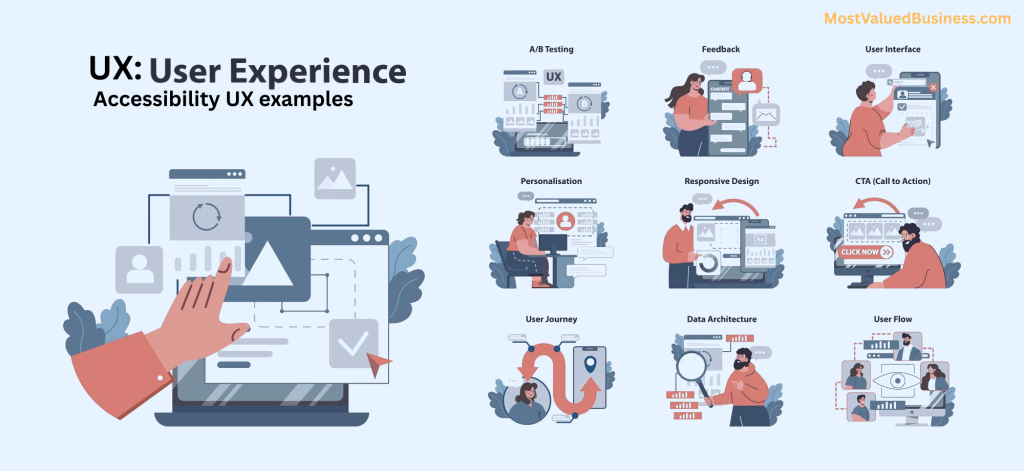Accessibility UX examples: what makes your website’s user experience accessible?
Designing a website that is visually appealing and easy to use is just the beginning. The real challenge (and opportunity) lies in ensuring that your digital product is accessible to everyone, regardless of their physical or cognitive abilities.
Keep in mind that accessibility in UX design isn’t just about compliance with laws or ticking a box in your project plan! It’s about creating digital spaces that are genuinely inclusive.
This article explores accessibility UX examples in depth, highlights examples from real-world brands, and explains how accessibility in UX design can be a continuous process that also serves to grow your business.
Why does accessibility matter in UX design?
In a nutshell?
Accessibility is about removing barriers that prevent people with disabilities from interacting with or accessing a website.
This includes those with visual impairments (like color blindness or low vision), auditory impairments, mobility challenges, or cognitive differences.
When your company prioritizes accessibility, it opens its product to a far broader audience.
- From a business perspective, it’s worth noting that accessible UX design improvements (such as better color contrast, clear navigation, and larger touch targets) improve usability for all users, not just those with disabilities. This universality is one of the strongest arguments for implementing accessibility UX design principles from the start: It increases engagement and strengthens brand reputation.
- Conversely, a lack of accessibility can alienate potential customers, lead to negative feedback, and in some jurisdictions, result in legal action.
Accessibility UX examples: 7 best practices suggested by UX agencies
Here are the seven best practices indicated by UX agencies…
- High-contrast color schemes
- Keyboard-friendly navigation
- Descriptive alt text for images
- Clear, logical heading structure
- Adjustable text and zoom
- Transcripts and captions for multimedia
- Error identification and guidance
Here’s a look at practical accessibility UX examples you can (and should) implement as soon as possible to create a more inclusive user experience…
1. High-contrast color schemes:
Ensuring text stands out against the background makes content readable for users with low vision or color blindness. Tools like the WCAG contrast checker can verify compliance.
2. Keyboard-friendly navigation:
Some users rely entirely on a keyboard or assistive device to navigate. All interactive elements should be accessible without a mouse.
3. Descriptive alt text for images:
Screen readers use alt text to describe images, ensuring visually impaired users receive the same information as other users.
4. Clear, logical heading structure:
Organizing content with headings (H1, H2, H3) helps both human users and assistive technologies understand the page’s hierarchy. Not to mention, it also improves your website’s SEO (Search Engine Optimization).
5. Adjustable text and zoom:
Users should be able to increase font size without the layout breaking. This helps those with vision impairments and mobile users alike.
6. Transcripts and captions for multimedia:
Providing captions for videos and transcripts for audio benefits not only hearing-impaired users but also those who try to access your content in noisy environments.
7. Error identification and guidance:
When a form submission fails, the error should be clearly explained and easy to fix.
Each of these accessibility UX examples addresses a specific user need, but together, they create the foundation of an inclusive, user-focused website. UX design agencies can also employ several other methods to make sure you deliver accessible content to your potential customers and extend your reach. For more details, click here: ergomania.eu.
Accessibility in UX design: examples from real brands
Some companies have provided excellent examples for accessibility in UX design that others can follow:
- Apple integrates VoiceOver, Magnifier, and Switch Control into all its devices, making them accessible straight out of the box.
- BBC applies a strict accessibility checklist to all its content, ensuring proper heading structures, alternative text, and keyboard navigation.
- Microsoft not only offers accessible products but also provides tools like Accessibility Insights for developers to test their work.
- Airbnb uses inclusive language and offers options for travelers with accessibility needs, such as filtering for wheelchair-accessible stays.
These organizations show that accessible UX design is not an afterthought. It is a core business value.
Accessibility in UX design is a continuous process
Accessibility in UX design is not a one-time task to check off before launch. Instead, it’s an evolving process that adapts to new technologies, devices, and user expectations.
Here’s how to keep accessibility at the forefront of your business:
- Regular accessibility and UX audits:– Use automated tools like Axe or Wave alongside manual testing with assistive technologies, or opt for the input of UX experts.
- User testing with diverse participants:– UX agencies can conduct testing that includes users with disabilities in usability studies to uncover issues that automated testing might miss.
- Stay updated with WCAG:– The Web Content Accessibility Guidelines are frequently updated, and staying compliant requires ongoing attention.
- Educate the team:– Designers, developers, and content creators should all understand the basics of accessibility and how their role impacts it.
This proactive approach ensures your product remains inclusive over time and avoids costly retrofitting later.
The business case for accessibility in UX design: — Examples
While accessibility is often framed as a moral or legal obligation, it’s also a smart business move.
- According to the World Health Organization, over 1 billion people worldwide live with some form of disability. That’s a significant market segment that is too large to ignore.
- Accessible design typically overlaps with good usability.
- For example, larger buttons are easier for users with motor impairments, but they also improve mobile navigation for everyone.
- Similarly, captions benefit hearing-impaired users and those watching videos in noisy environments.
By embracing accessibility in UX design, your business can improve customer satisfaction, increase its reach, and enhance brand loyalty.
Accessibility UX examples: — Final thoughts
Inclusive design benefits everyone. The best accessibility UX examples show that making your site more accessible not only supports users with disabilities but also creates a smoother, more enjoyable experience for all. Looking at accessibility in UX design examples from leaders in the field, it’s clear that accessibility is more than a trend. It’s a necessity for modern digital products.
Whether you’re improving an existing site or building something new, integrating accessibility UX design principles from the very beginning will pay off in happier users, better engagement, and a stronger reputation.
Remember: Accessibility is not a feature. It’s a commitment. And it’s one worth making.
Read Also:




